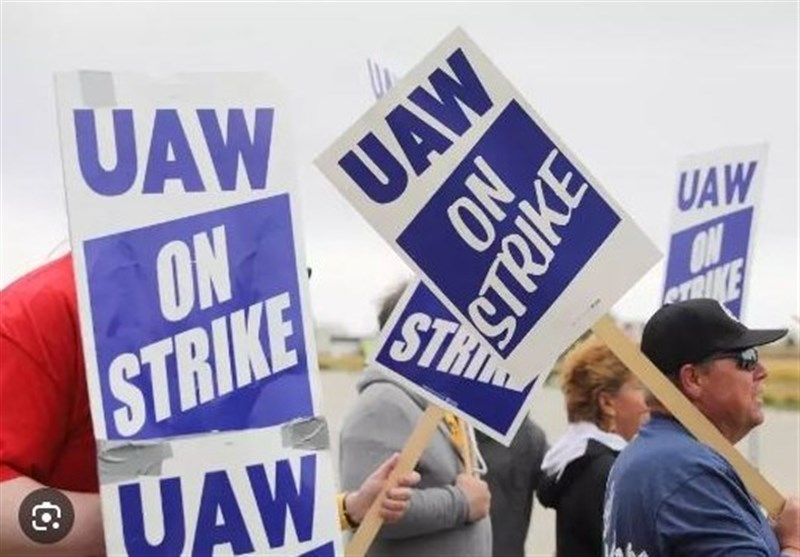UAW Union Just Ordered 6,800 Workers to Strike A Massive Ram Truck Facility
TEHRAN (Tasnim) – The United Auto Workers union sent 6,800 Stellantis employees to the picket line Monday morning in a surprise, targeted strike at the company’s Ram truck facility.
The Sterling Heights Assembly Plant is Stellantis’ “largest plant and biggest moneymaker,” UAW said in a statement Monday. The plant, about a half-hour north of Detroit, in Sterling Heights, Michigan, produces the Ram 1500 pickup, CNN reported.
The union said the company, which makes vehicles under the Dodge, Ram, Jeep and Chrysler brands, has “the worst proposal on the table” in its negotiations on pay, converting temporary workers to full time and cost-of-living adjustments.
“Despite having the highest revenue… the highest profit margins, and the most cash in reserve, Stellantis lags behind both Ford and General Motors in addressing the demands of their UAW workforce,” the UAW said.
Stellantis said it believed that progress was being made in negotiations with the union, and appeared caught off guard by the union’s decision to strike its largest plant.
“We are outraged that the UAW has chosen to expand its strike action against Stellantis. Last Thursday morning, Stellantis presented a new, improved offer to the UAW,” said the company’s statement. “Following multiple conversations that appeared to be productive, we left the bargaining table expecting a counter-proposal, but have been waiting for one ever since.”
“The UAW’s continued disturbing strategy of ‘wounding’ all the Detroit 3 will have long-lasting consequences,” the company added. “With every decision to strike, the UAW sacrifices domestic market share to non-union competition.”
The Ram pickup trucks are Stellantis’ best-selling vehicles in the US market. It sold 332,000 Ram pickups in the United States in the first nine months of this year. But it is not the only plant that builds the Ram 1500. They are also produced at a nonunion plant in Mexico, as well as another UAW-represented plant in Warren, Michigan. Stellantis does not disclose how many pickups come out of each plant, but Sterling Heights is the largest of the plants building the trucks.
Wells Fargo analyst Colin Langan said in a note to clients that the shutdown of Sterling Heights will likely be a $110 million a week hit to Stellantis’ earnings before interest and taxes. That is more than double the cost of the strike for company, taking the total cost of the strike to Stellantis to roughly $200 million a week, he said.
Sterling Heights produces about 1,000 trucks a day, six days a week, or about 300,000 trucks a year, according to Jeff Schuster, global head of automotive for GlobalData, an industry consultant. The average sales price of a Ram 1500 stands at $64,235, so 300,000 trucks at that price could produce revenue of almost $20 billion a year. Stellantis would not comment on those estimates.
This is the second “surprise” targeted strike in two weeks by the UAW. The first was at Ford on October 11, when the UAW went on strike at that automaker’s largest plant, the Kentucky Truck Plant in Louisville. Vehicles made at Ford’s Kentucky Truck Plant produce annual revenue of $25 billion according to Ford, and Wells Fargo’s Langan estimates its shutdown is costing Ford about $150 million a week.
Stellantis was formed in 2021 through the merger of Fiat Chrysler and European automaker PSA Group, maker of French automotive brands like Peugeot and Citroen.
There are now more than 40,000 UAW members on strike as it enters its sixth week, with 14,600 on now on strike at Stellantis, joining the 16,600 on strike at Ford and 9,200 on strike at GM.
The strike started September 15 with one assembly plant at each company and 12,700 UAW members on strike, but the union’s strategy has been to increase pressure on the companies by adding new strike targets in subsequent weeks.
Fain told members that all three companies are now offering record contracts to the union, but that the union would remain on strike because it believes the companies could all agree to even bigger gains to members, given the strong profits all are reporting, to make up for the concessions the unions gave the companies when they were struggling in the past.
Stellantis said it is now offering 23% in wage increases over the life of the contract that runs through early 2028, as well as nearly a 50% increase in company contributions to the retirement accounts of workers hired since 2007 who are not eligible for a traditional pension plan, and additional job security protections.
“Our very strong offer would address member demands and provide immediate financial gains for our employees,” said the company statement. “Instead, the UAW has decided to cause further harm to the entire automotive industry as well as our local, state and national economies.”
There are now two assembly plants on strike at both Stellantis and GM and three assembly plants at Ford, as well as networks of parts distribution networks at both GM and Stellantis.
But the union has stopped short of having all 145,000 members at the three companies all be on strike.
The Big Three automakers have laid off thousands of workers as a result. The first five weeks of the strike has had an economic impact of $9.3 billion, according to Anderson Economic Group, with the three automakers suffering losses of $4.2 million between them. The automakers’ suppliers have lost $2.8 billion between them in lost profits and wages, and the UAW members at the automakers who are on strike or have been laid off by the companies during the strike have lost nearly $500 million in wages, according to Anderson.
So far only GM has disclosed any of the losses from the strike. It said that it cost the company $200 million in the first two weeks alone. GM is due to report quarterly earnings tomorrow and Ford is scheduled to report results after the market close on Thursday. Stellantis, being based in Europe, does not report quarterly profits or losses, only full-year and six-month results. But it is due to report quarter sales and revenue on October 31.






